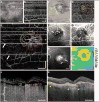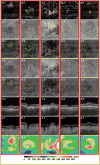Ultrahigh-speed swept-source OCT angiography in exudative AMD
- PMID: 25423628
- PMCID: PMC4712918
- DOI: 10.3928/23258160-20141118-03
Ultrahigh-speed swept-source OCT angiography in exudative AMD
Abstract
Background and objective: To investigate the potential of ultrahigh-speed swept-source optical coherence tomography angiography (OCTA) to visualize retinal and choroidal vascular changes in patients with exudative age-related macular degeneration (AMD).
Patients and methods: Observational, prospective cross-sectional study. An ultrahigh-speed swept-source prototype was used to perform OCTA of the retinal and choriocapillaris microvasculature in 63 eyes of 32 healthy controls and 19 eyes of 15 patients with exudative AMD.
Main outcome measure: qualitative comparison of the retinal and choriocapillaris microvasculature in the two groups.
Results: Choroidal neovascularization (CNV) was clearly visualized in 16 of the 19 eyes with exudative AMD, located above regions of severe choriocapillaris alteration. In 14 of these eyes, the CNV lesions were surrounded by regions of choriocapillaris alteration.
Conclusion: OCTA may offer noninvasive monitoring of the retinal and choriocapillaris microvasculature in patients with CNV, which may assist in diagnosis and monitoring.
Copyright 2014, SLACK Incorporated.
Figures



References
-
- Rosenfeld PJ, Moshfeghi AA, Puliafito CA. Optical coherence tomography findings after an intravitreal injection of bevacizumab (Avastin) for neovascular age-related macular degeneration. Ophthalmic Surg Lasers Imaging Retina. 2005;36(4):331–335. - PubMed
-
- Kaiser PK, Blodi BA, Shapiro H, et al. Angiographic and optical coherence tomographic results of the MARINA study of ranibizumab in neovascular age-related macular degeneration. Ophthalmology. 2007;114(10):1868–1875. - PubMed
-
- Fung AE, Lalwani GA, Rosenfeld PJ, et al. An optical coherence tomography-guided, variable dosing regimen with intravitreal ranibizumab (lucentis) for neovascular age-related macular degeneration. Am J Ophthalmol. 2007;143(4):566–583. - PubMed
-
- Lalwani GA, Rosenfeld PJ, Fung AE, et al. A variable-dosing regimen with intravitreal ranibizumab for neovascular age-related macular degeneration: year 2 of the PrONTO Study. Am J Ophthalmol. 2009;148(1):43–58. - PubMed
-
- Hong YJ, Miura M, Makita S, et al. Noninvasive investigation of deep vascular pathologies of exudative macular diseases by high-penetration optical coherence angiography. Invest Ophthalmol Vis Sci. 2013;54(5):3621–3631. - PubMed
Publication types
MeSH terms
Grants and funding
LinkOut - more resources
Full Text Sources
Other Literature Sources

